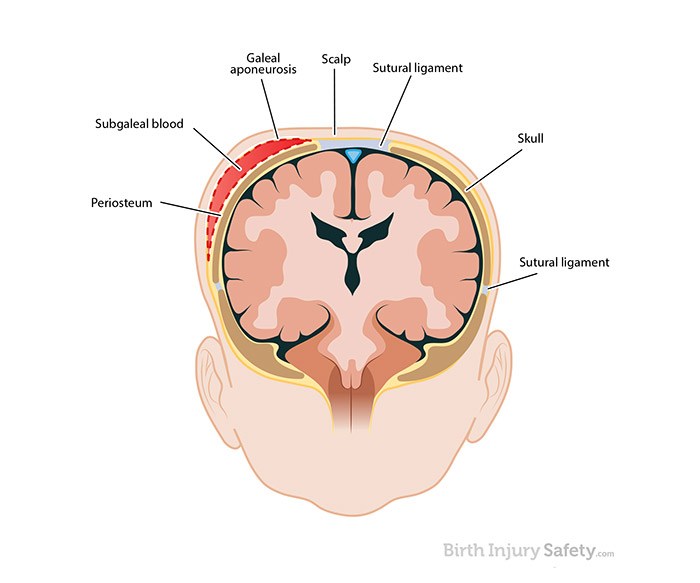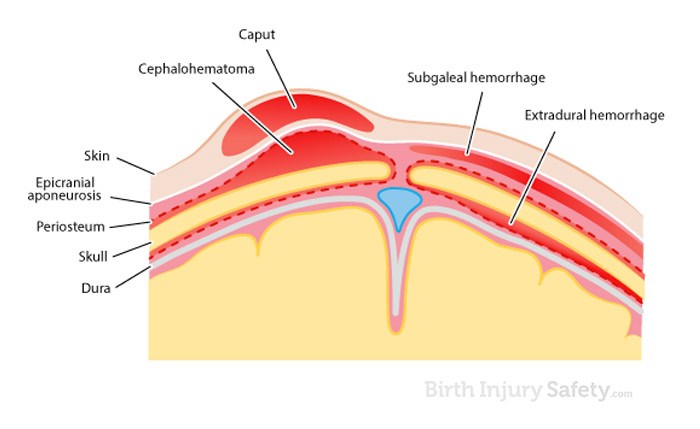Injuries Due to a Vacuum Extraction Delivery
Vacuum extraction delivery is a form of assisted vaginal delivery. Medical providers apply a medical device – a vacuum extractor – to the baby’s head. During contractions, the vacuum extractor is pressurized to create suction on the baby’s head. The medical provider uses the vacuum extractor to pull on the baby’s head during contractions.
Vacuum extractors are potentially dangerous devices if used incorrectly or by inexperienced medical providers. In 1998, the United States Food and Drug Administration issued a Public Health Advisory to doctors, nurses, hospital obstetric departments, and risk managers warning that vacuum-assisted delivery devices may cause serious or fatal complications to babies. Injuries that are known to be caused by vacuum extraction deliveries include subgaleal hemorrhage and intracranial hemorrhage. Because of the potentially deadly injuries, the FDA recommended that the vacuum extraction devices be used ONLY WHEN A SPECIFIC OBSTETRIC INDICATION IS PRESENT and that the medical providers who use the device be versed in their use and aware of the indications, contraindications, and precautions.

Injuries Caused by Vacuum Extraction
Some injuries caused by vacuum extraction include:
- Intracranial hemorrhage
- Cephalohematoma
- Subgaleal hemorrhage
- Caput Succedaneum

What is a Vacuum Extractor?
During vacuum extraction, a doctor may use a vacuum-like device to guide or pull the baby down and out of the birth canal. The medical device is known as a vacuum extractor. A suction cup is inserted and attached to the baby’s head. The medical device is pressurized to create suction so that the cup stays in place on the baby’s head. The suction cup is attached to a handle that the doctor holds in his or her hand. During a contraction, the doctor pulls on the handle to guide or pull the baby down the birth canal. A vacuum extraction delivery is a special type of delivery known as an operative vaginal delivery. Doctors who perform vacuum extraction deliveries require special training because of the potential dangers to the baby.
Dangers of Vacuum Extraction Delivery
Vacuum extractors can cause serious injuries to babies, particularly if the vacuum extractor is used improperly by the doctor or is used when it is not medically indicated. There are certain medical situations in which the doctor should abandon the use of the vacuum extractor. For example, if the suction cup pops off the baby’s head while the doctor is pulling on the handle, that may indicate that the baby is stuck in the birth canal. Continuing to pull on the baby’s head can cause serious injury.
Food and Drug Administration (FDA) Warns of Dangers of Use of Vacuum Extractors
In 1998, the Food and Drug Administration issued a Public Health Advisory to doctors, nurses, hospital obstetric departments and hospital risk managers warning that vacuum assisted delivery devices may cause serious or fatal complications to babies. Because of the potentially deadly injuries, the FDA recommended that the vacuum extraction devices be used ONLY WHEN A SPECIFIC OBSTETRIC INDICATION IS PRESENT and that medical providers who use the device be versed in their use and aware of the indications, contraindications and precautions.
Vacuum Extractor Injuries to Babies
Use of a vacuum extractor can cause other types of complications that range in severity:
Hemorrhage (Brain Bleeds):
Hemorrhaging refers to the loss of excessive amounts of blood, and vacuum extraction is known to cause different types of hemorrhages or bleeding in the skull or brain:
Subgaleal hemorrhage: This is a very serious complication of vacuum extraction delivery. This is bleeding in the connective tissue of the subgaleal space – the spaced between the skull periosteum and the scalp galea aponeurosis. A baby with a subgaleal hemorrhage may have:
- Boggy or “mushy” scalp from swelling
- Swelling across the suture lines of the skull
- Expanding head circumference
- Hypovolemia – blood loss from the hemorrhage decreasing the amount of blood available to circulate to the baby’s brain and vital organs. This blood loss can lead to hypovolemic shock
- Pale appearance, also known as pallor
- Tachycardia – excessive heart rate
- Falling hematocrit – percentage of red blood cells in the total volume of blood.
Intracranial hemorrhage: This is bleeding inside the baby’s skull. This type of hemorrhage occurs when the vacuum extractor suction cup damages blood vessels inside the skull resulting in hemorrhage or bleeding in the skull. Symptoms of intracranial hemorrhage include:
- Seizures
- Difficulty feeding
- Irritability fussiness
- Lethargy or sleepiness
- Altered level of consciousness
- Apnea or episodes where the baby stops or slows breathing
- Decreased tone
- Bulging fontanelle or bulging “soft spot” on the baby’s head.
Cephalohematoma
Cephalohematoma occurs when a child bleeds beneath the skin on their skull. Cephalohematomas can be caused by trauma to the baby’s head during delivery, including force on the head as the baby descends down the mother’s pelvis in the birth canal. Cephalohematomas are most commonly caused by forceps or vacuum extraction deliveries. Cephalohematoma is a risk factor for neonatal jaundice and sepsis and may continue to worsen even after birth. Cephalahematomas usually resolve when the bleeding is resorbed in the baby’s body. However, if the baby has neurologic symptoms similar to those listed above, it may be necessary to do radiologic studies to look for more severe hemorrhaging.
Vacuum Extractor Injuries Are Preventable
After the FDA issued the Public Health Advisory in 1998 warning of potentially dangerous complications of vacuum extractors, hospitals and doctors should be well-trained on the indications and contraindications for use of a vacuum extractor.
Maternal Indications for use of a Vacuum Extractor include:
- Need to avoid voluntary maternal expulsive efforts – for example, the mother has a medical condition in which pushing and vaginal delivery would be dangerous for her
- Mother’s efforts to push the baby out for delivery are not effective or adequate
- Maternal exhaustion – the mother has pushed and is too tired to push effectively
Fetal (Baby) Indications for use of a Vacuum Extractor include:
- Baby has a nonreassuring heart rate indicating that baby may be suffering from lack of oxygen
- Prolonged second stage of labor (pushing stage)
- Failure to progress in the second stage of labor
The relative contraindications for Vacuum Extractor Delivery include:
- The baby is premature (<34 weeks gestation)
- Trauma to the baby’s scalp
- The baby’s head is not engaged in the mother’s pelvis
- The mother’s cervix is not completely dilated
- Suspected macrosomia (baby is large in size and likely to get stuck)
- Abnormal presentation of the baby in the birth canal
- CPD – cephalopelvic disproportion – the baby’s head or pelvis is too large to fit through the mother’s pelvis
Sufficient training and experience are critical to the safe use of the vacuum extractor and the prevention of injury to the baby. Doctors and nurses should be trained on the indications and contraindications for use of the vacuum extractor and should be trained to know when attempts at vacuum extraction should be stopped to prevent injury.
Contact Us Today
Contact our birth injury attorneys today at +1 (866) 393-2611 if your child has suffered an injury related to prenatal care, labor, or delivery. We are dedicated professionals with years of experience and are here to help you.


